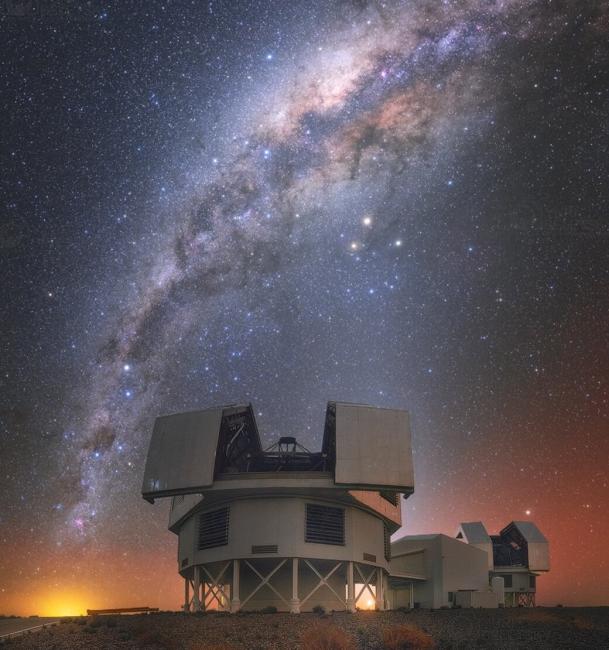Magellan Telescopes
The twin Magellan Telescopes in Chile are each 6.5 meter optical telescopes. These telescopes are both equipped with instruments to take images and spectra of light from a wide variety of astronomical sources, including exoplanet systems, star-forming regions, supernova remnants, and interacting galaxies. The Magellan Telescopes — named Baade and Clay — are hosted at the Las Campanas Observatory and are operated by a consortium of institutions, including the Center for Astrophysics | Harvard & Smithsonian, Carnegie Institution for Science, University of Arizona, the University of Michigan, and the Massachusetts Institute of Technology. In addition, CfA scientists and engineers provided a wide field f/5 focal system (including secondary mirror and corrective optics), and a powerful astronomical camera for use at the Clay telescope.

This photograph shows the Milky Way in the skies over the twin Magellan Telescopes, located at Las Campanas Observatory in Chile.
The Telescopes and the Science
The Magellan Telescopes both have 6.5-meter mirrors, making them the same size as the MMT Observatory at CfA’s Fred Lawrence Whipple Observatory (FLWO) in southern Arizona. The Las Campanas Observatory, which hosts the telescopes, is located at an elevation of 2400 meters in the Atacama Desert of Chile. The high elevation and dry conditions lead to good observational conditions for more than 300 nights of the year.
The two telescopes are named for astronomer Walter Baade, one of the early researchers into supernovas and galactic structure, and philanthropist Landon T. Clay. The Magellan Baade telescope began observations in 2000, while the Clay telescope started in 2002. The Magellan Clay Telescope is equipped with adaptive optics: flexible secondary mirrors that change shape to compensate for distortions in images caused by air. Adaptive optics allow the Magellan Clay Telescope to produce extremely clear, sharp images.
The Magellan Telescopes carry a suite of instruments designed to produce those images, as well as analyze the spectrum of light from astronomical sources. One of those instruments on the Clay telescope is Megacam, which was designed built by scientists and engineers at the CfA. This is an array of 36 charge-coupled device (CCD) detectors, the same basic technology used in digital cameras, each of which produces images 2048 X 4608 pixels in size. Other instruments include spectrographs for splitting light into its component colors to identify chemical composition and measure motion: the Magellan Inamori Kyocera Echelle (MIKE), the Low Dispersion Survey Spectrograph (LDSS3-C), the FIRE (Folded port InfraRed Echellette), and the MagE (Magellan Echellette) Spectrograph. The Inamori Magellan Areal Camera and Spectrograph (IMACS) both takes images and measures spectra, and the FIRE (Folded port InfraRed Echellette) spectrograph allows the Baade telescope to study infrared spectra.
The Magellan Telescopes are powerful general purpose observatories, used to study a wide variety of astronomical objects from the Solar System to distant galaxies. For example, the Magellan Planet Search project uses the MIKE instrument and the Planet Finder Spectrograph on the Clay telescope to identify exoplanets.
Instruments
Optical
IMACS - moderate dispersion multi-slit spectrograph and imager
MagE - moderate dispersion single-slit echellette spectrograph
Near-IR
FourStar - wide-field imagerbefore Oct 2020no
FIRE - high dispersion single-slit echelle spectrographYESno
Optical
Megacam - wide-field imager
LDSS-3 - moderate dispersion multi-slit spectrograph
MIKE - high dispersion single-slit echelle spectrograph
M2FS - fiber-fed multi-object spectrograph
PFS - high dispersion single-slit echelle spectrograph
PISCO - parallel imager
Near-IR
MagAO - adaptive optics imager(s)
- What is the universe made of?
- How do stars and planets form and evolve?
- Why do galaxies differ so much in size, shape, composition and activity?
- Why do we need an extremely large telescope like the Giant Magellan Telescope?
- Machine Learning
- Atomic & Molecular Data
- Gravitational Waves
- Masers
- Medical Applications
- Planetary Geology
- Space Weather
- Solar and Stellar Atmospheres
- Cosmic Microwave Background
- Cosmology
- The Milky Way Galaxy
- Stellar Astronomy
- The Energetic Universe
- Instrumentation
- Extragalactic Astronomy
- Planetary Systems